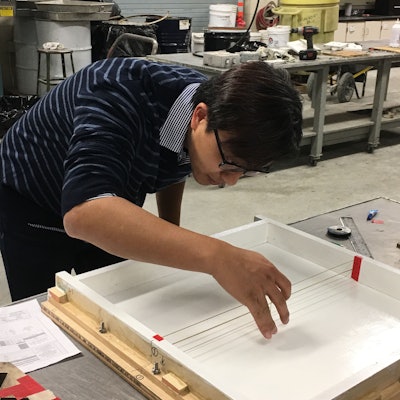 Hongyan Ma. Photo courtesy of Missouri University of Science and Technology.
Hongyan Ma. Photo courtesy of Missouri University of Science and Technology.Hongyan Ma, an assistant professor of civil, architectural and environmental engineering at the Missouri University of Science and Technology, is working to develop a safe, simple and more affordable method to combine nanoparticles with concrete.
“Our method is to create calcium carbonate nanoparticles inside the concrete by blowing carbon dioxide into the highly diluted wet cement,” says Ma in a university press release. “The nanoparticles will be formed inside this part of the suspension in the presence of siliceous ingredients, and you use that to mix the concrete.”
Ma explains that earlier attempts to add nanoparticles to fresh concrete were not successful because the superfine particles would always stick together rather than disperse. His new method involves forming the nanoparticles inside the fresh concrete, creating an even disbursement.
The fact that the new method is a wet method is said to take care of another potential problems for people working with nanoparticles in concrete. They have harmful side effects, especially when dry particles are used, including potential lung inflammation and heart problems.
“Concrete durability is one of the main issues in preservation of transportation infrastructure,” Dr. Genda Chen, the Robert W. Abbett Distinguished Chair in Civil Engineering at S&T, says in the press release. “If you could reduce microcracking and increase durability in concrete, that would certainly be a good benefit for all concrete structures.”
Missouri S&T is one of only a few U.S. universities that studies materials for construction and other applications through Advanced Materials for Sustainable Infrastructure (AMSI).
“We hope to grow the AMSI signature research area to be best in class in the critical field of transportation infrastructure,” says Dr. Kamal Khayat, the Vernon & Maralee Jones Professor of Civil Engineering and director of Missouri S&T’s Center for Infrastructure Engineering Studies (CIES), in the press release, adding that such fundamental research combined with numerical studies and simulations will lead to the development of new construction materials.
Ma will be able to test the method for creating nanoparticles in concrete through 2021, thanks to a $160,000 grant from the National Science Foundation. By then, he hopes to have the technology available to make the method ready for use by concrete plants. He also hopes to work with CIES at Missouri S&T and the Missouri Department of Transportation on pilot trials and field tests.










